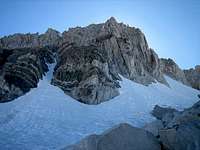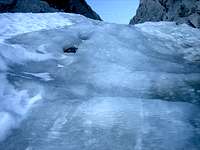|
|
Route |
|---|---|
|
|
37.38170°N / 118.7783°W |
|
|
Mountaineering, Ice Climbing |
|
|
Fall |
|
|
Most of a day |
|
|
grade I, AI1, class 4 |
|
|
Overview
This couloir up the east side of Mount Dade offers a fun and straightforward ice route along with some class 4 rock scrambling to reach the summit. Approaching from the easy trailhead at Mosquito Flat makes this route very doable in a single day's outing. The couloir is thin at places narrowing to about 3 ft in the middle section but offers about 550 feet of both great ice and neve in total. The route finding and class 4 up the ridge to the summit is quite doable making this a great possible introductory alpine ice route.
Getting There
The easiest approach starts at the Mosquito Flats trailhead. The parking lot is located at ~10,300 ft and the trail is relatively flat and quite scenic winding around likes and under trees. After passing long lake on the hiker's right, take a side trail splitting off right which heads up to the Treasure Lakes. If overnighting, anyone of the four Treasure Lakes is great with some primitive spots already made.
From here climb up the drainage that leads to the base of the Hourglass Couloir but cut northwest (climber's right) up along the east side of Dade. From here the forth couloir you reach on the left is your route.
Route Description
There are four noticeable couloirs that stem up from a snowfield that stretches all the way to Abbot: the first is a noticeable "Y" shape terminating well below the summit; the second and third are smaller and fail to even reach halfway up to the ridge; finally the forth is the couloir described here. The forth couloir is the only one of which runs from bottom to just nearly the top of the visible ridge. In mid-september of 2006, the first three couloirs contained only snow or neve whilst only in the forth was found any water ice; thus is why it was climbed.
Climb the couloir. In the middle it thins into ~3 ft wide of dirty ice embedded with tiny rocks and sand grains. After climbing through this, the route in mid september (of 2006) was mostly neve to the top with about 40 more feet of ice at the end. But in later season it is more than likely that more ice will be formed. Near the very top the couloir splits; the left split offers a nicer area to take off crampons and get on the rock. From here climb the rock either up directing toward the summit continuously bypassing all class 5 sections to your left. Descend the Hourglass Couloir back to Treasure Lakes.






